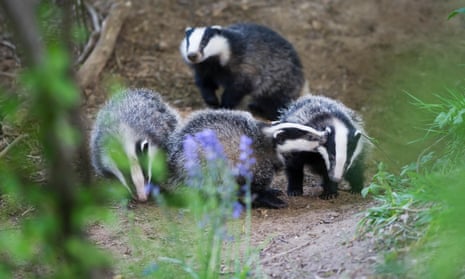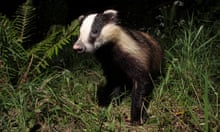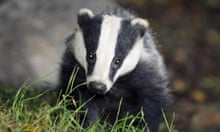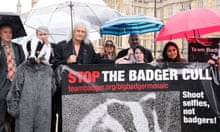Badgers and cattle never came into close contact during a new field study examining how tuberculosis (TB) is transmitted between the animals.
Most TB in cattle is contracted from other cattle but some infections come from badgers. The new research indicates that the disease is not passed on by direct contact, but through contaminated pasture and dung, with potentially significant implications for farm practices such as slurry spreading.
It also suggests why TB in cattle is so hard to control even when cattle and badgers are culled, as the bacteria can survive in fields for months. Eradicating TB will require addressing this risk, the new research implies.
TB is a serious problem for farmers, with 36,000 infected cattle slaughtered in Britain in 2015 at a cost to the taxpayer of about £100m. One key element of the government’s control programme, England’s controversial badger cull, is set to expand.
But the UK’s foremost experts say this “flies in the face of scientific evidence” and that the cull is a “monstrous” waste of time and money. The new research has not changed their conclusion.
The new study, carried out on 20 farms in Cornwall, aimed to shed light on how TB is transmitted between badgers and cattle, a route estimated to be directly responsible for about 6% of herd infections. “We know badgers can give TB to cattle but we have never known how,” said Prof Rosie Woodroffe, at the Zoological Society of London, who led the new research. “It is really difficult to track the movement of what is invisible - the pathogen.”
The breakthrough came thanks to new technology: a GPS collar small enough to be worn by badgers. The researchers tracked more than 400 cattle when they were in the territories of 100 badgers, with the total number of tracked days coming to more than 8,000.

“We detected nothing [in way of interactions],” said Woodroffe. Just once in 65,000 observations did a badger get within 10 metres of a cow and they preferred to be 50m away. In contrast, they are thought to need to be within 1.5m of a cow to directly transmit TB. “It looks most likely that the badgers are avoiding the cattle,” she said, although close contact has been seen on rare occasion in the past.
“Badger-to-cattle and cattle-to-badger transmission is therefore most likely happening through the environment,” said Woodroffe. “That raises the possibility that some cattle to cattle transmission is happening through the environment. That is an important issue as TB isn’t seriously managed as though the environment is infectious.”
When TB is detected in a herd, the infected cattle are isolated and sent for slaughter. “But the pasture they are grazing and the slurry or manure they contributed to isn’t treated as if it is contaminated. That can still be squirted all over the environment, as slurry is spread widely,” she said, adding that this might explain how closed herds can be infected from neighbouring farms.
The researchers, whose study was funded by the Department of Environment, Food and Rural Affairs (Defra) and is published in Ecology Letters, are now sampling the fields to see exactly where the TB is harboured. This will help farmers understand which biosecurity measures - such as fencing off badger latrines or raising water troughs - actually work.
“There is this mass of measures that farmers are supposed to do, but no-one knows if they really work,” said Woodroffe. “In trying to eradicate a disease, you are trying to nail every transmission route.”
Prof Alastair MacMillan, veterinary adviser for Humane Society International/UK, said: “The suggestion by some that TB is spread by frequent nose-to-nose contact between badgers and cattle has now been completely dismissed.”
“It is much more likely that contamination by cattle of fields and yards by [TB bacteria] is the cause of repeated TB herd breakdowns,” said MacMillan, a former Defra scientist. “It’s clear that the government must divert the substantial resources being used needlessly to cull badgers and instead improve farmer education and biosecurity on farms.”
A Defra spokeswoman said: “Tighter cattle controls and good biosecurity are a key part of our comprehensive strategy to beat bovine TB, and a number of measures are in place to prevent the spread of infection.”
“These include frequent testing and rapid removal of infected cattle, pre- and post-movement testing and wildlife proofing of high risk units,” she said. “To reduce the risk of cattle to cattle transmission from contaminated environment, farmers are required to carry out cleaning and disinfection and to keep cattle out of fields grazed by [infected cattle] for two months after their removal. There are also rules about the use of manure and slurry on infected farms to mitigate the risks.”
Woodroffe said the new research has not changed her opinion that the current badger cull should be halted, but she said it could explain why only a slow reduction in TB was seen in earlier, scientific culls: “The feeling has always been with badgers that you kill an infected badger and the infection is gone, but it’s not.”
She warned: “The benefits of badger culling accrue really slowly but the harmful effects [such as spreading TB more widely] happen really fast.”






Comments (…)
Sign in or create your Guardian account to join the discussion